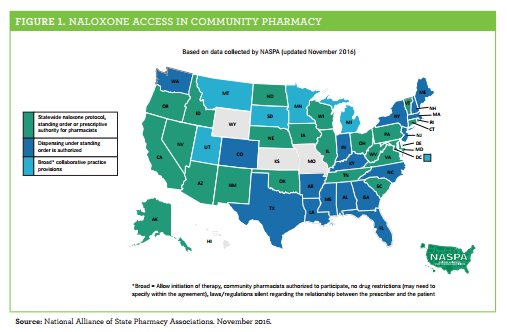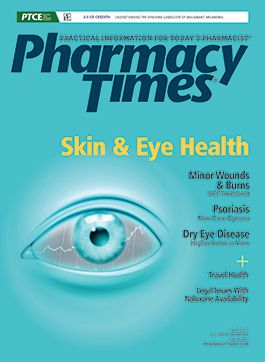
Publication
Article
Pharmacy Times
Legal Issues With Naloxone Availability Conferring Authority and Insulating From Liability
The rise of opioid overdoses nationally has expanded the role of pharmacists and advocacy for pharmacists to apply their knowledge and talents to emergency situations.
The rise of opioid overdoses nationally has expanded the role of pharmacists and advocacy for pharmacists to apply their knowledge and talents to emergency situations. According to the CDC, 91 Americans die from opioid overdose each day.1 The following are designed to address the opioid epidemic: needle-exchange programs, prescription drug monitoring programs, safe opioid prescribing education, supervised injection facilities, and the increase in access to the opioid antagonist naloxone.
The World Health Organization has listed naloxone in its Model Lists of Essential Medicines for many years and has conducted many studies in which participants have shown very strong support for increasing the availability of naloxone for managing opioid overdose.2 Naloxone is available in 48 states and the District of Columbia under legislative and regulatory approaches that vary by state (Figure 1).
In October 2014, the National Association of Boards of Pharmacy (NABP) acknowledged the rise in drug overdoses by collaborating with representatives from other national associations and with federal and state officials to “support programs that involve an active role for pharmacists in expanding access to the opioid overdose reversal drug, naloxone.”3 The availability of naloxone for distribution in emergencies is expanding the role of pharmacists in addressing the associated public health crisis.
CONFERRING AUTHORITY TO ISSUE THE MEDICATION
State law determines which categories of health professionals are given prescribing authority. Outright grants of prescriptive authority, also known as statewide protocols for pharmacists, are typically enacted for preventing disease or for conditions that are easily diagnosed. The prevention category includes immunizations, medications for smoking cessation, and travel medications; the “easily diagnosed” category includes hormonal contraceptives, strep throat treatments, and naloxone for drug overdose emergencies.4
In 1996, Chicago started the first US naloxone program, the Chicago Recovery Alliance, to extend takehome medications to the community.5 In March 2014, the House of Delegates of the American Pharmacists Association approved policies to assist in preparing and supporting statutes and regulations authorizing pharmacists to “furnish opioid reversal agents and to support pharmacists’ role in selecting therapy, dosing, initiating therapy, and providing education on proper use of opioid reversal agents in efforts to prevent opioid-related deaths due to overdose.”6 For most of the past 2 decades, New Mexico has had the highest drug overdose death rates in the nation, leading that state, through a board of pharmacy regulation, to be the first to legalize pharmacists’ prescriptive authority to dispense naloxone.7
Twenty-three US states have given pharmacists prescriptive authority or have a statewide naloxone protocol authorizing the use of preloaded syringes or nasal sprays. Pharmacists can implement such services by meeting the qualifications outlined in the protocol without a physician’s prescription. This is viewed as complementary to the essential skills pharmacists obtain in pharmacy school. The policy elements of statewide protocols are customized to be consistent with individual states’ statutes and regulations.8 In the coming years, the National Alliance of State Pharmacy Associations and the NABP will likely work to facilitate standardization in legislative authority for statewide protocols for pharmacist prescriptive authority, such as with naloxone. Although the requirements and restrictions of state statutes and regulations vary, the overall objective is to allow pharmacists to actively practice clinical judgment to prevent extremely serious consequences of opioid-related overdose.
In May 2016, the US House of Representatives considered HR 4588, known as Lali’s Law. This bill would have amended the Public Health Service Act to authorize the Department of Health and Human Services to generate grants to states that permit standing orders for naloxone prescriptions or the dispensing of other opioid overdose reversal medications. Proposed, but not enacted, legislation would have allocated $5 million to be used for grants during fiscal years 2017 to 2019.9 A standing order is a document executed by a health care professional with authority to prescribe medication who can authorize another person to act once predetermined conditions have been met to obtain, dispense, or administer medication without a person-specific prescription.10

Turning to the state level, in August 2016, Wisconsin outlined the policies and procedures for a standing order to implement the most appropriate clinical practice reflecting recent medical research and enable pharmacists across the state to dispense an opioid antagonist without a prescription. The statewide standing order for the use of naloxone is “intended for pharmacies that do not have their own medical provider to issue a prescription order.”11 States such as Maryland and Pennsylvania use the approach of a statewide standing order in which the top physician of the state, the physician general, issues a statewide written order that naloxone use can be authorized under conditions outlined in the standing order.12 Representatives of management at pharmacies for which statewide naloxone standing orders for pharmacists are applicable must sign the document to enable licensed pharmacists practicing in these pharmacies to initiate dispensing of naloxone. In addition, these pharmacists must meet the requirements established by a state agency, such as a health department, to complete certification training. Standing order agreements with prescribers or state regulators have been secured for national pharmacy chains such as CVS and Walgreens to facilitate compliance with legal requirements in the states where they operate. As of June 2016, Walgreens pharmacists were authorized to dispense naloxone without a patient-specific prescription at over 1500 pharmacies across 9 states. Walgreens had an objective to extend this practice to the other states where this would be possible, covering pharmacists in 8200 pharmacies.13
The least common naloxone access approach is to establish broad collaborative practice agreements that may require a separate agreement for each pharmacist. A naloxone collaborative practice agreement is a written document whereby a licensed physician or other practitioner delegates the medication management control of naloxone to a pharmacist. The collaborative practice agreement document must identify the scope of practice, state the intention of the agreement, and identify each practitioner and pharmacist. It must be physically or electronically signed by all participants and include the name and location of the pharmacy.14 Depending on the authority conferred by the collaborative practice agreement, the pharmacist(s) may initiate naloxone therapy, configure appropriate dosing, or conduct patient or third-party education in using intranasal naloxone, as well as discuss the importance of rescue breathing.
IMMUNITY FROM PROFESSIONAL LIABILITY
As the need for naloxone has increased, so has the need for overdose immunity laws, such as the Good Samaritan law, to protect the pharmacist and physician from legal action for activities undertaken to preserve life. Currently, 37 states and the District of Columbia have some form of a “911 drug immunity law” (online figure 2). As with many state statutes, various approaches to scope of breach are included regarding protection, transgressions covered by the provisions, and the point at which immunity applies.15 In the various approaches for conferring prescriptive authority to pharmacists for naloxone use, whether a standing order or a collaborative practice agreement, pharmacists must be acting in good faith with an ethical approach to patients. The same would apply to third-party prescribing, which is dispensing of the medication to a caregiver, family member, or friend to assist the patient in case of an overdose. Montana and South Dakota do not authorize naloxone to be supplied without a prescription to a third party; those jurisdictions only limit providing the medication directly to the patient.16
Accessibility of naloxone is becoming more widespread, but there is a lack of guidance on the use of naloxone by bystanders who witness an overdose in a nonhospital setting. Increasingly, police officers and other emergency responders are being provided with the medications to use when appropriate. Naloxone has been reclassified as an OTC product in many countries, creating speculation as to whether the FDA will do the same.
Miley G. Nikirk, is a second-year PharmD student at the University of Kentucky College of Pharmacy.Joseph L. Fink III, BSPharm, JD, DSc (Hon), FAPhA, is a professor of pharmacy law and policy and the Kentucky Pharmacists Association Professor of Leadership at the University of Kentucky College of Pharmacy, Lexington.
References
- Drug overdose deaths in the United States continue to increase in 2015. CDC website. cdc.gov/drugoverdose/epidemic. Accessed March 22, 2017.
- Community management of opioid overdose. World Health Organization website. http://www.drugs.ie/resourcesfiles/ResearchDocs/Global/WHO_Naloxone.pdf. Accessed March 22, 2017.
- NABP issues policy statement supporting the pharmacist’s role in increasing access to opioid overdose reversal drug. National Association of Boards of Pharmacy website. nabp.pharmacy/nabp-issues-policy-statement-supporting-the-pharmacists-role-in-increasing-access-to-opioid-overdose-reversal-drug/. Accessed March 22, 2017.
- Statewide protocols for pharmacist prescribing in the US. National Alliance of State Pharmacy Associations website. naspa.us/resource/statewide-protocols-for-pharmacist-prescribing. Accessed March 22, 2017.
- Chicago Recover Alliance case study.” Harm Reduction Coalition website. http://harmreduction.org/issues/overdose-prevention/tools-best-practices/naloxone- program-case-studies/chicago-recovery-alliance/. Accessed March 22, 2017.
- Robinson M. Combating opioid drug abuse with naloxone. Pharmacy Today website. http://www.pharmacist.com/ combating-opioid-drug-abuse-naloxone. Published September 1, 2014. Accessed March 22, 2017.
- Pharmacist prescriptive authority for naloxone. New Mexico Board of Pharmacy website. http://prescribetoprevent.org/wp2015/wp-content/uploads/Naloxone-pharmacist-Rx-authority-protocol_NM.pdf. Accessed March 22, 2017.
- Pharmacist collaborative practice agreements: key elements for legislative and regulatory authority. National Alliance of State Pharmacy Associations website. https://www.accp.com/docs/positions/misc/NASPACPAWG.pdf. Accessed March 22, 2017.
- H.R. 4586, 114th Cong. § 341 (2016).
- H.R. 4586, 114th Cong. § 341(g)(2) (2016).
- Statewide naloxone standing order for pharmacists. State of Wisconsin Department of Health Services website. https://www.dhs.wisconsin.gov/forms/f01802.pdf. Accessed March 22, 2017.
- Standing orders. Naloxone Info website. naloxoneinfo.org/case-studies/standing-orders. Accessed March 22, 2017.
- McCue M. Pharmacies juggle state regulations for non-prescription naloxone.” Behavioral Healthcare Executive. www.behavioral.net/ article/pharmacies-juggle-state-regulations-non-prescription-naloxone. Published June 3, 2016. Accessed March 22, 2017.
- Using law to support pharmacy naloxone distribution. The Network for Public Health Law website. networkforphl.org/_asset/qdkn97/Pharmacy-Naloxone-Distributions.pdf. Accessed March 22, 2017.
- Drug overdose immunity and good Samaritan laws.” National Conference of State Legislatures website. ncsl.org/research/civil-and-criminal-justice/drug-overdose-immunity-good-samaritan-laws.aspx. Accessed March 22, 2017.
- Naloxone can save lives by reversing opioid overdose but legal barriers may prevent its use. Recovery Research Institute website. www.recoveryanswers.org/pressrelease/naloxone-can-save-lives-by-reversing-opioid-overdose-but-legal-barriers-may-prevent-its-use. Accessed March 22, 2017.

2 Commerce Drive
Cranbury, NJ 08512
All rights reserved.





